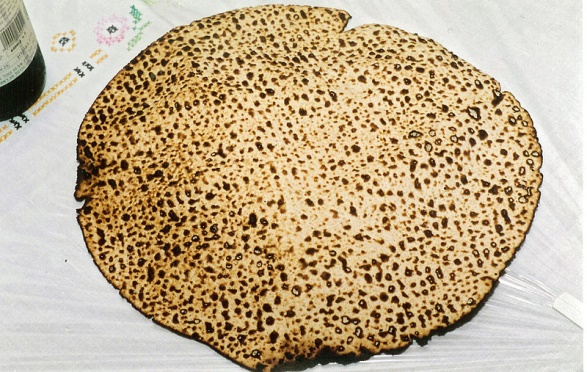12 Mar. The first Passover
“The Lord spoke to Moses and Aaron in the land of Egypt. ‘This month will be the beginning of months, the first month of the year for you.’”
“’Tell the whole community of Israel that on the tenth day of this month each man must get one lamb for the people in his house. If there are not enough people in his house to eat a whole lamb, he must share it with his closest neighbour. There must be enough lamb for everyone to eat.’”
“’The lamb must be a one-year-old male that has nothing wrong with it. This animal can be either a young sheep or a young goat.’”
“’Take care of the animals until the fourteenth day of the month. On that day all the people of the community of Israel will kill them in the evening before dark.’”
“’The people must take some of the blood and put it on the sides and tops of the doorframes of the houses where they eat the lambs. On this night they must roast the lamb over a fire. They must eat it with bitter herbs and bread made without yeast.’”
“’Do not eat the lamb raw or boiled in water. Roast the whole lamb over a fire – with its head, legs and inner organs. You must not leave any of it until morning, but if any of it is left over until morning, you must burn it with fire.’”
“This is the way you must eat it: you must be fully dressed as if you were going on a trip. You must have your sandals on and your walking stick in your hand. You must eat it in a hurry; this is the LORD’s Passover’”
“’That night I will go through the land of Egypt and kill all the firstborn animals and people in the land of Egypt. I will also punish all the gods of Egypt. I am the LORD.’”
“’But the blood will be a sign on the houses where you are. When I see the blood, I will pass over you. Nothing terrible will hurt you when I punish the land of Egypt.’”
“’You are always to remember this day and celebrate it with a feast to the LORD. Your descendants are to honour the LORD with this feast from now on. For this feast you must eat bread made without yeast for seven days… You must celebrate the Feast of Unleavened Bread, because on this very day I brought your divisions of people out of Egypt. So all your descendants must celebrate this day.’”
(Exodus 12:1-17)

Today’s reading from Exodus Chapter 12 introduces us to the origin of the Jewish festival of Passover.
To escape God’s promise to kill all the firstborn sons in Egypt, the Israelites were told to put blood from a slaughtered lamb (the ‘Passover lamb’) on the doorposts of their houses so the LORD would pass over them and would not harm the firstborn of the Israelites.
For the next seven days, the Israelites were to eat bread made without yeast. This bread could be prepared quickly, without waiting for the yeast to rise, so the Israelites could leave Egypt immediately, as soon as the signal was given.
To remember their rescue from Egypt, God declared that every year, the Jews were to celebrate a religious festival to remember how the Angel of Death passed over their firstborn sons but killed the children of their Egyptian overlords.
Blood was used as a sign of protection (see Exodus 12:13), and a roasted lamb shank was to be eaten to represent the Passover lamb whose blood was smeared on the doorframes to protect the Israelites from death.
Although it’s often referred to as the ‘Passover Festival’, the original name for the festival was the ‘Feast of Unleavened Bread’. This was because, at the time of the Exodus from Egypt, the Israelites were told to make bread without any ‘leaven’ (in the form of yeast) which, over several hours, normally causes bread to ‘rise’ and take on a lighter texture. This unleavened bread could be prepared without waiting for the dough to rise, so the Israelites would be ready to leave Egypt at short notice.
When Jewish families celebrate the Passover Festival today, they still eat unleavened bread (‘matzos’) to remind them that, at the first Passover, the Israelites didn’t have time to let their bread rise before escaping from Egypt. During the Passover supper, three pieces of unleavened bread are broken symbolically. The middle piece (the ‘aphikomen’) – representing the Passover lamb – is hidden at the start of the meal, but is later searched for by the children, then broken and shared towards the end of the supper.
During the supper, four cups or ‘chalices’ of wine are symbolically passed round, reminding all present of God’s four promises to rescue the Jews from Egypt (see Exodus 6:6-7). They also dip bitter herbs (‘karpas’) or pieces of celery into a dish of ‘haroseth’ - a sugary mixture of apple, walnuts and cinnamon – which is shared symbolically at Passover to sweeten the bitter memories of slavery in Egypt.
In the New Testament, Jesus is referred to as “the Lamb of God” as his blood was shed as a sacrifice – like a Passover lamb – to save his people from death and to give them eternal life (see John 1:29).
The photo (by Yoninah) shows a hand-made matzo (a piece of unleavened bread) eaten by Jews at the Passover Festival (the Feast of Unleavened Bread).
You can read more about the first Passover @ https://www.thebiblejourney.org/biblejourney2/25-the-israelites-journey-from-egypt-to-mt-sinai/egypt-suffers-ten-plagues
